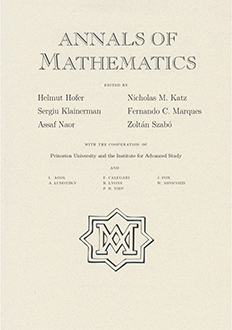Jeff Cheeger, Wenshuai Jiang, Aaron Naber
Ann. of Math. (2) 193 (2), 407-538, (March 2021) DOI: 10.4007/annals.2021.193.2.2
KEYWORDS: Ricci, curvature, stratification, rectifiability, 53B20, 35A21
This paper is concerned with the structure of Gromov-Hausdorff limit spaces $(M^n_i,g_i,p_i)\stackrel{d_{GH}}{\longrightarrow} (X^n,d,p)$ of Riemannian manifolds satisfying a uniform lower Ricci curvature bound $\mathrm{Ric}_{M^n_i}\geq -(n-1)$ as well as the noncollapsing assumption $\mathrm{Vol}(B_1(p_i))>\mathrm{v}>0$. In such cases, there is a filtration of the singular set, $S^0\subset S^1\cdots S^{n-1}:= S$, where $S^k:=${$x\in X:$ no tangent cone at $x$ is $(k+1)$-symmetric}. Equivalently, $S^k$ is the set of points such that no tangent cone splits off a Euclidean factor $\mathbb{R}^{k+1}$. It is classical from Cheeger-Colding that the Hausdorff dimension of $S^k$ satisfies $\mathrm{dim}\, S^k\leq k$ and $S=S^{n-2}$, i.e., $S^{n-1}\setminus S^{n-2}=\emptyset$. However, little else has been understood about the structure of the singular set $S$.
Our first result for such limit spaces $X^n$ states that $S^k$ is $k$-rectifiable for all $k$. In fact, we will show for $\mathcal{H}^k$-a.e.\ $x\in S^k$ that \textit{every} tangent cone $X_x$ at $x$ is $k$-symmetric, i.e., that $X_x= \mathbb{R}^k\times C(Y)$ where $C(Y)$ might depend on the particular $X_x$. Here $\mathcal{H}^k$ denotes the $k$-dimensional Hausdorff measure. As an application we show for all $0\lt \epsilon\lt \epsilon(n,\mathrm{v})$ there exists an $(n-2)$-rectifiable closed set $S^{n-2}_\epsilon$ with $\mathcal{H}^{n-2}(S_{\epsilon}^{n-2}) \lt C(n,\mathrm{v},\epsilon)$, such that $X^n\setminus S^{n-2}_\epsilon$ is $\epsilon$-bi-Hölder equivalent to a smooth Riemannian manifold. Moreover, $S=\bigcup_\epsilon S^{n-2}_\epsilon$. As another application, we show that tangent cones are unique $\mathcal H^{n-2}$-a.e.
In the case of limit spaces $X^n$ satisfying a $2$-sided Ricci curvature bound $|\mathrm{Ric}_{M^n_i}|\leq n-1$, we can use these structural results to give a new proof of a conjecture from Cheeger-Colding stating that $S$ is $(n-4)$-rectifiable with uniformly bounded measure. We can also conclude from this structure that tangent cones are unique $\mathcal H^{n-4}$-a.e.
Our analysis builds on the notion of quantitative stratification introduced by Cheeger-Naber, and the neck region analysis developed by Jiang-Naber-Valtorta. Several new ideas and new estimates are required, including a sharp cone-splitting theorem and a geometric transformation theorem, which will allow us to control the degeneration of harmonic functions on these neck regions.

